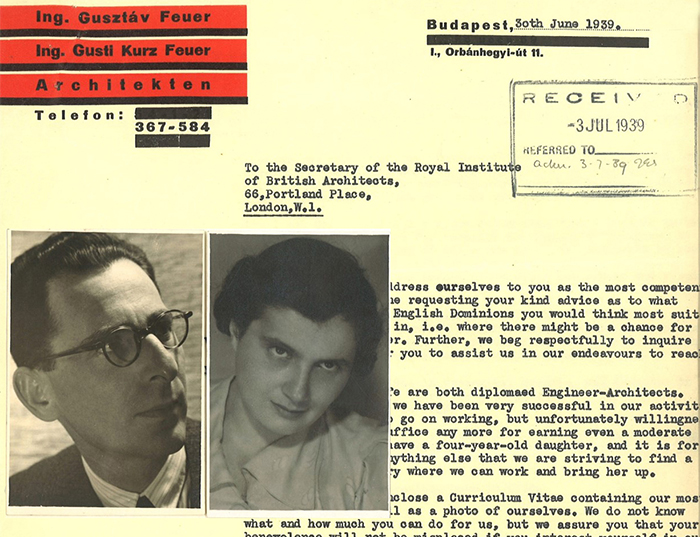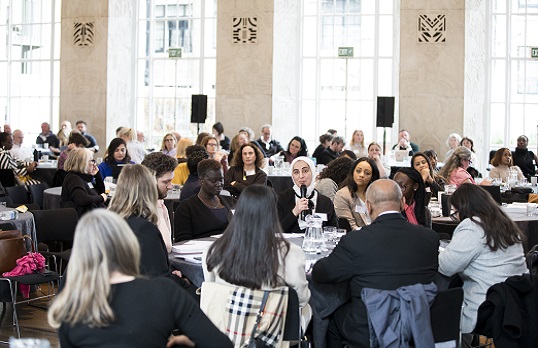In January 1939, the Royal Institute of British Architects (RIBA) set up a special committee to deal with the increasing number of requests for assistance from architects situated in Nazi-occupied central Europe.
Between 1938 and 1941, more than 200 individuals (mostly architects) became known to RIBA and its Refugee Committee, either directly or via other refugee organisations. Some of these architects had already achieved recognition, while others had barely managed to embark on their careers.
Some succeeded in emigrating and rebuilding their lives abroad. Of those who stayed behind, many did not survive the war. The Refugee Committee Papers, which include the related correspondence and record the activities of the committee, are held in the RIBA Archives and have inspired ongoing research on the topic, of which this conference would be the first major output.
Conference information
To highlight these individuals and their extraordinary work, RIBA will be hosting a hybrid conference, planned to take place at 66 Portland Place in London during Refugee Week on 21 and 22 June 2024.
The conference seeks to give back a voice to those often-forgotten architects and to celebrate their lives and their work. It also aims to provide a better understanding of the phenomenon of migration in the late 1930s of one particular profession from continental Europe to the United Kingdom and beyond.

Call for papers
As part of the conference programme, we are looking for 30 minute papers that can shed light on the work and fate of architects who tried to emigrate from Germany, the former Czechoslovakia, Austria, and Hungary due to religious, ethnic or political persecution.
Please contact photo@riba.org before sending your abstract so that we can confirm the architect(s) you are researching are among those who came to the attention of RIBA during this time.
We would also welcome papers on the more general topic of the migration of architects from central Europe to a specific country such as the United States, Canada, Australia etc.
Interested participants are invited to submit the following, no later than 5pm (BST) on 15 April 2024:
- presentation title
- 300 word abstract of your paper
- brief biography
We strongly encourage participants to consider presenting rather than reading their papers. Please email your submission to photo@riba.org.
About RIBA's Refugee Committee
Hitler’s rise to power in 1933 saw the beginning of systematic discrimination and persecution of certain groups of the German population: initially political opponents and those of Jewish heritage, and then increasingly anyone who was not considered ‘Aryan’, heterosexual or in line with the party’s politics and views.
People started losing their positions, their jobs, their access to education and the possibility to provide for themselves or their families. As they felt they could no longer stay in Germany, many decided to emigrate and Britain was one of the few countries they believed could provide refuge, particularly for its longstanding tradition of tolerance.
In their attempt to relocate to Britain, they were joined later in the decade by inhabitants of other countries affected by Germany’s expansion policy, such as Austria, the former Czechoslovakia and eventually Hungary. The refugees came from a variety of different backgrounds, including the architectural profession.
In response to the sharp rise in related requests for admission to this country, RIBA set up a special committee in January 1939, which was tasked to strike a difficult balance between giving assistance to foreign colleagues and safeguarding job opportunities for local architects in a period of economic uncertainty.
The RIBA Refugee Committee, headed by the RIBA Librarian Edward ‘Bobby’ Carter, considered and acted on urgent cases, made recommendations to the Home Office, undertook statistical analysis and consulted other professional institutes. Carter eventually produced a detailed report for the RIBA Council, which was praised in the architectural press for its clarity. The activities of the committee, however, were cut short by the outbreak of the Second World War in September of the same year.
At least 140 individuals were brought to the attention of the RIBA Refugee Committee in its short lifespan. Many of them managed to build a new life in Britain or countries outside Europe; others were not so lucky and perished in concentration camps.
Some, despite being recommended by the committee for labour permits or supported by prominent British architects, were unable to leave their countries in time. Among them, notable Czech architect and graphic designer František Zelenka, who died at Auschwitz in 1944.
Others suffered a different fate: German architect Eric Gloeden, who had been in London for a period in 1939, died a few years later with his wife at the hands of the Gestapo, having given shelter to one of the individuals involved in the failed 1944 plot to assassinate Adolf Hitler. Both, and all their colleagues who were victims of the Holocaust, deserve to be remembered, and their work and life celebrated.
Their stories are part of a wider narrative, which should serve as a constant reminder of the dangers brought about by intolerance, fear and discrimination.
As mentioned, research into the RIBA Refugee Committee Papers is ongoing. Future outputs will include an online database of the architects represented in the papers, with plans for an exhibition and a publication which will help to further disseminate the research’s findings.









